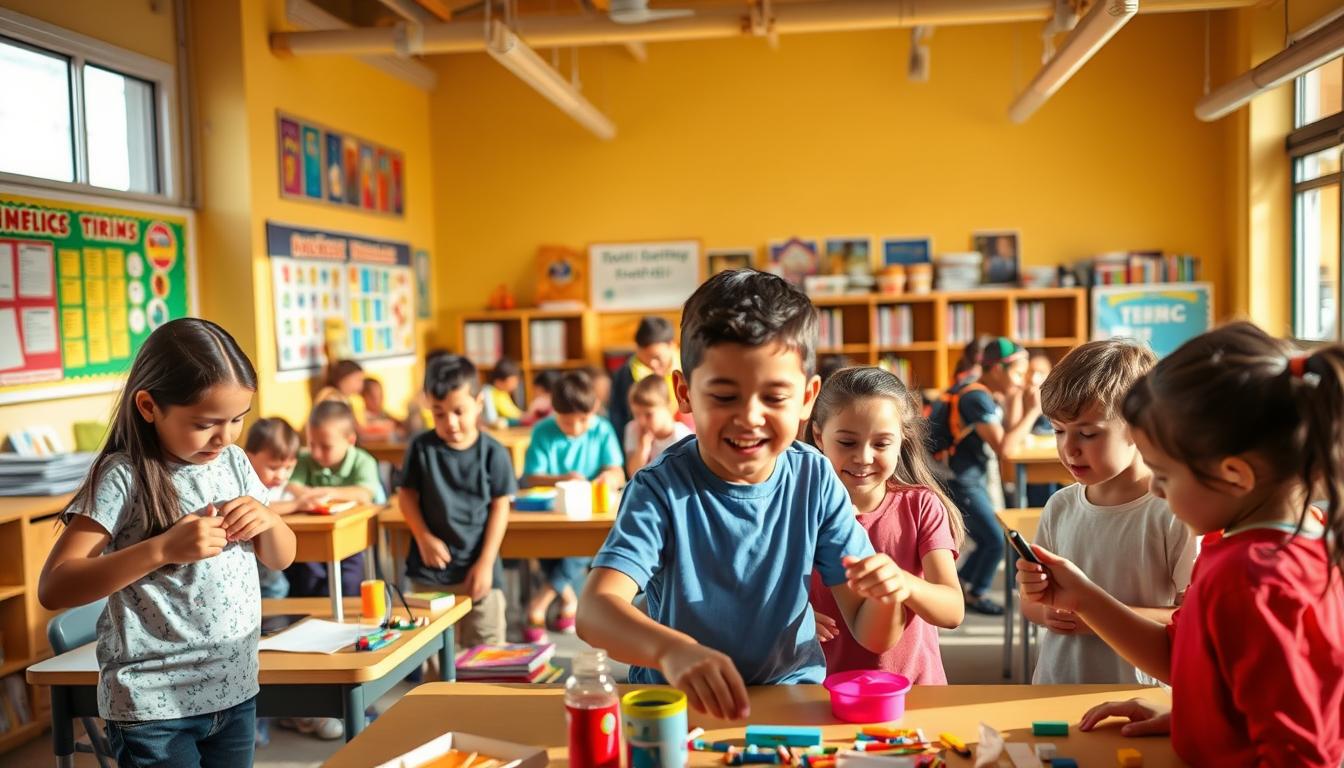Fun Kinesthetic Learning Activities to Boost Engagement
Did you know students retain 75% more information when physically involved in lessons compared to sitting through lectures? Research from the National Training Laboratories reveals this staggering gap in educational outcomes. For 1 in 5 young learners, traditional teaching methods simply don’t stick—they thrive when their bodies and minds work together.
This approach isn’t about letting kids fidget or play games all day. It’s rooted in science: kinesthesia—the awareness of body movement—helps cement ideas through action. Classrooms that embrace this style see higher participation, better focus, and lasting results. Imagine turning math drills into relay races or history lessons into interactive role-plays.
Educators across the U.S. are rethinking old routines. Why? Because when students build models, act out scenarios, or solve problems with their hands, abstract concepts click faster. These methods don’t just help kinesthetic learners—they create dynamic environments where every child can excel.
Key Takeaways
- Active participation boosts retention rates by up to 75%
- 15-20% of students learn best through physical engagement
- Movement-based lessons improve focus across all learning styles
- Hands-on strategies make abstract subjects easier to grasp
- Modern classrooms increasingly prioritize experiential methods
Introduction: Exploring the Power of Kinesthetic Learning
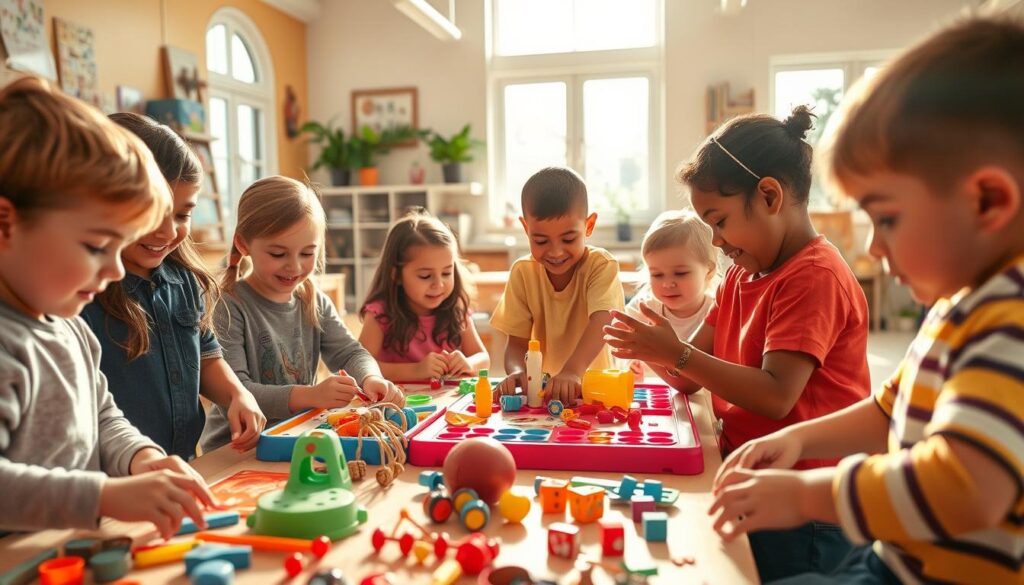
What if tapping a pencil or shuffling feet could actually help students absorb information? Science shows motion sparks neural connections that static listening can’t match. When learners interact with materials physically, their brains form stronger memory pathways.
This approach transforms classrooms into dynamic spaces where kids build knowledge through doing. As Dr. Carla Hannaford, author of Smart Moves, notes:
“Movement anchors thought by linking ideas to muscle memory. When students physically engage with concepts, they’re not just learning—they’re embodying knowledge.”
Traditional and movement-based methods differ sharply:
| Approach | Focus | Engagement | Retention |
|---|---|---|---|
| Lecture-based | Auditory input | Passive | 20-30% |
| Hands-on | Multi-sensory | Active | 70-85% |
Some assume fidgety learners just need to sit still. But research proves the opposite—physical activity helps them process complex ideas. By connecting the body to lessons, educators unlock new ways for students to demonstrate understanding.
These strategies aren’t about burning energy. They create concrete links between actions and abstract concepts, helping learners master subjects from fractions to foreign languages through purposeful motion.
What Are Kinesthetic Learners?
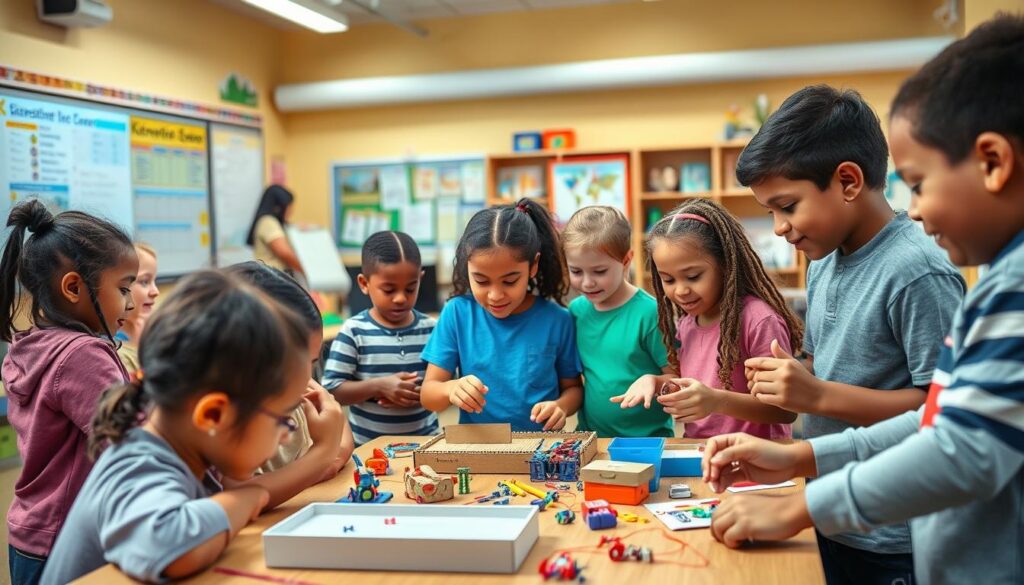
Have you ever noticed a child who can’t sit still during storytime but thrives when building models? These students often process information through motion and touch—a hallmark of kinesthetic learners. Unlike peers who excel with lectures or diagrams, they learn best by doing, whether assembling puzzles or acting out stories.
Defining Characteristics and Learning Styles
Young learners with this style frequently fidget, doodle, or ask to handle objects. You might see them tearing apart toys to see how they work or mirroring a teacher’s gestures during lessons. For these children, physical interaction isn’t distraction—it’s how they connect ideas to real-world concepts.
Traditional classrooms can frustrate them. Sitting still limits their ability to absorb information. Instead, they thrive in environments where they can:
- Use their hands to solve problems
- Move while reviewing material
- Engage in role-playing scenarios
Benefits of a Hands-On Approach
When teachers incorporate movement, even simple adjustments yield results. Math becomes tangible with counting blocks. Science clicks during lab experiments. One study found students in active classrooms scored 22% higher on retention tests than peers in lecture-based settings.
This way of teaching doesn’t just help kinesthetic learners—it creates inclusive spaces where all students benefit. Movement breaks mental fatigue, while tactile tools make abstract ideas concrete. As one educator shared: “When I let kids build vocabulary with clay, even reluctant readers participate eagerly.”
Kinesthetic Learning Activities
How can educators turn ordinary lessons into dynamic experiences? The answer lies in strategic physical engagement that sparks both curiosity and comprehension. These methods adapt seamlessly across subjects while strengthening neural connections through action.
Hands-On Techniques and Tools
Simple tools revolutionize standard lessons. Math becomes tactile with fraction tiles. Grammar sticks better when shaping letters with clay. Consider these adaptable approaches:
- Manipulative math stations using beads or blocks
- Vocabulary charades with full-body gestures
- Science concept sorting with movable cards
A 3rd-grade teacher shared: “When we replaced worksheets with puzzle-piece timelines, historical events clicked instantly.” This versatility makes lessons memorable without expensive resources.
Practical Examples from the Classroom
Real-world applications show dramatic results. Middle schoolers act out chemical bonds through partner movements. Elementary classes build landform models with kinetic sand. Observe the differences:
| Traditional Lesson | Movement-Based Version | Engagement Boost |
|---|---|---|
| Textbook diagrams | Human body system role-play | +68% participation |
| Spelling lists | Jump rope letter sequences | 41% fewer errors |
| Lecture on ecosystems | Habitat simulation game | 2.3x retention |
These strategies work because they merge physical action with cognitive tasks. Students processing geometry through dance steps or historical events through reenactments gain deeper understanding. Best part? Most require only creativity and everyday materials.
Hands-On Learning with Manipulatives and Role Play
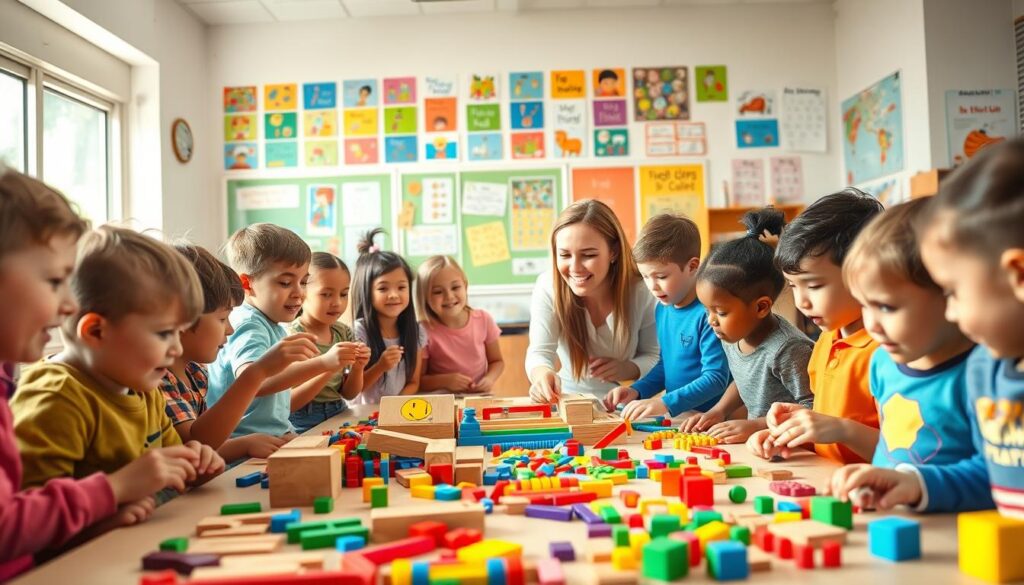
Manipulatives aren’t just for math class anymore—they’re secret weapons across subjects. Simple objects like blocks or craft supplies turn abstract ideas into touchable lessons. Pair these tools with role-play scenarios, and classrooms buzz with discovery.
Using Manipulatives for Diverse Subjects
Think beyond counting beads. Everyday items become powerful teaching aids in every subject:
| Subject | Manipulative | Skill Developed |
|---|---|---|
| Science | Spray bottle + cotton balls | Water cycle visualization |
| Social Studies | Index card timelines | Chronological reasoning |
| Language Arts | Color-coded sentence strips | Grammar mastery |
A 4th-grade teacher reported: “When we swapped textbook diagrams for hands-on watershed models, test scores jumped 34%.”
Role Play for Real-Life Skills
Pretend scenarios do more than teach content—they build teamwork and critical thinking. Students debating as historical figures or acting out science processes gain confidence alongside knowledge.
| Activity | Academic Focus | Life Skill |
|---|---|---|
| Mock courtroom trials | Civic systems | Persuasive communication |
| Grocery store math | Decimal operations | Budget planning |
These activities let learners test ideas safely. As one principal noted: “Our students now solve playground conflicts using role-play skills from social studies lessons.”
Engaging Activities for Active Movement
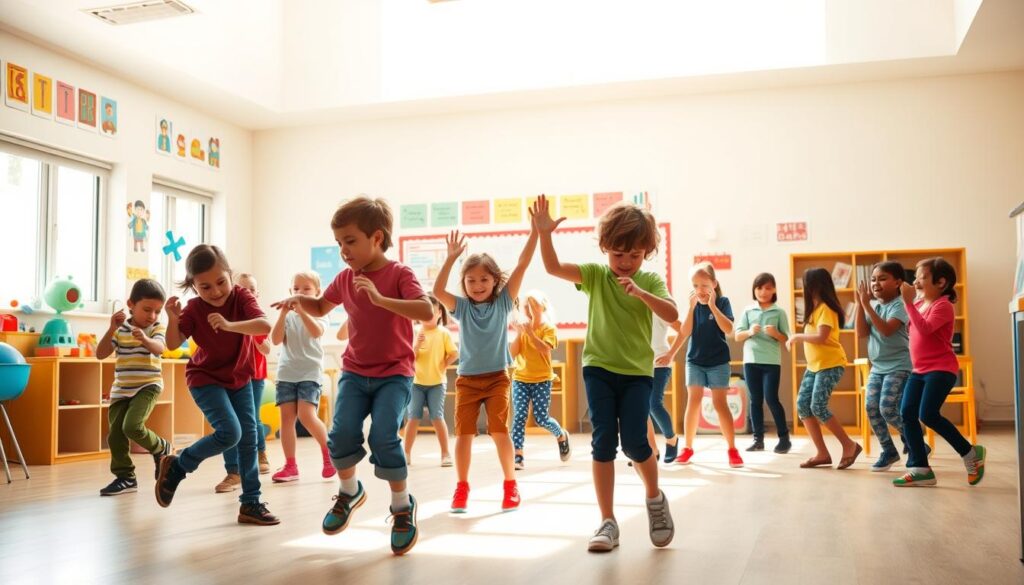
Ever watched students light up when they get to move around during lessons? Movement-based activities turn classrooms into vibrant spaces where energy fuels understanding. These methods don’t just burn calories—they spark neural connections that make lessons stick.
Let’s explore three crowd-pleasers that merge physical activity with academic goals:
| Activity | Subject Adaptation | Movement Benefit |
|---|---|---|
| Beach Ball Q&A | Write math problems or story prompts on each panel | Full-body coordination + quick thinking |
| Subject Charades | Act out historical events or science processes | Nonverbal communication skills |
| Action Songs | Create lyric motions for vocabulary terms | Rhythmic memory reinforcement |
Beach ball reviews work magic across grades. Toss a ball marked with questions about the Civil War or multiplication tables. “When kids catch it, their thumb lands on a query—no opting out!” shares a 5th-grade teacher. This approach keeps everyone alert and laughing.
For older students, try charades with academic twists. Teams might mime photosynthesis stages or geometric terms. One high schooler noted: “Pretending to be a right angle helped me remember complementary measures.”
Action songs shine in language classes. Add hand motions to grammar rules or historical timelines. A 2nd-grade class improved spelling test scores by 28% after creating dance moves for vowel patterns.
These activities serve dual purposes: they reset focus during long lessons while cementing content. Best of all, they prove that movement and mastery make perfect partners.
Creative Activities: From Clothespin Punctuation to Sculptures
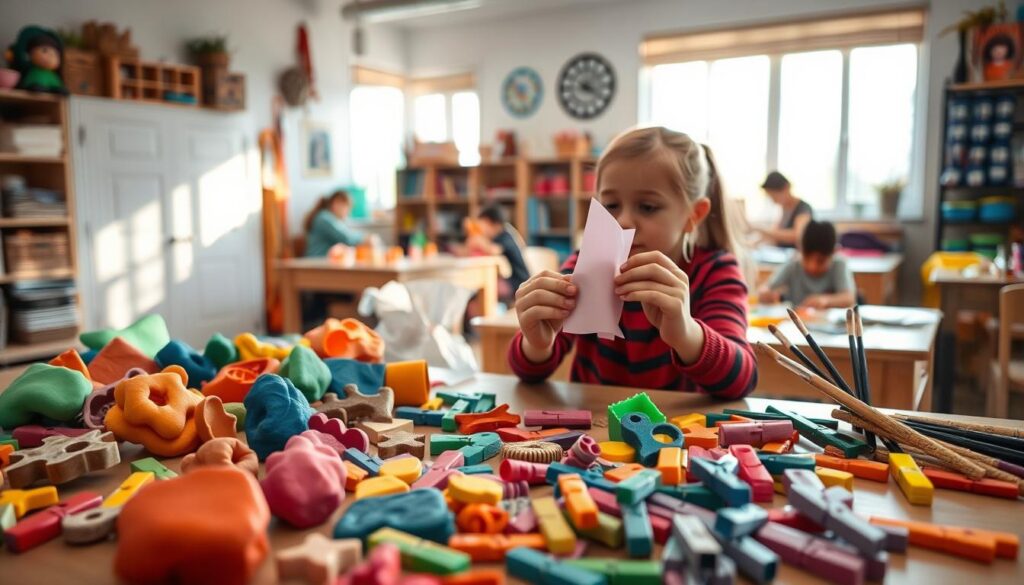
What transforms grammar drills into exciting challenges and vocabulary into 3D adventures? Simple objects like clothespins and craft supplies become bridges between abstract ideas and concrete understanding.
Clothespin Punctuation Techniques
Turn sentence structure practice into a hands-on game. Write sentences without punctuation on strips of paper. Students snap clothespins marked with commas or periods onto the correct spots. “They physically feel where pauses belong,” explains a 4th-grade teacher. This method helps students visualize sentence flow while building muscle memory for grammar rules.
Building Sculptures to Represent Vocabulary
Challenge students to mold clay or foil into shapes that capture a word‘s meaning. A “symbiosis” sculpture might show intertwined organisms. This pushes thinking beyond definitions to symbolic representation. One middle schooler shared: “Shaping ‘revolution’ from wire made me understand its circular nature.”
Both activities turn complex concepts into touchable experiences. They let students demonstrate understanding through creativity rather than tests. Best part? You only need everyday materials to launch these brain-boosting activities.
Classroom Strategies and Tips for Teachers
Imagine transforming your classroom into a buzzing hive of collaboration using just hula hoops and note cards. This low-cost strategy turns abstract concepts into tactile group challenges. Teachers report 40% faster concept mastery when students physically organize information together.
Group-Based Movement and Collaboration
Start with two hula hoops per group. Provide cards with terms, equations, or historical events. Watch students debate where items belong in Venn diagrams or category zones. A 5th-grade educator shared: “During our ecosystem unit, kids sorted organisms into biome hoops—they argued using textbook evidence!”
| Subject | Hula Hoop Use | Skill Developed |
|---|---|---|
| Math | Sort odd/even numbers | Classification |
| Science | Compare animal habitats | Critical thinking |
| Literature | Group story elements | Plot analysis |
Keep groups small (3-4 students) to ensure participation. Set clear rules: “Two feet in a hoop means you’re deciding.” Rotate roles weekly—facilitator, recorder, timekeeper. This builds leadership skills alongside content knowledge.
| Traditional Groups | Movement Groups | Outcome Difference |
|---|---|---|
| Paper worksheets | Physical sorting | +53% engagement |
| Quiet discussion | Active negotiation | 2x verbal participation |
Concerned about noise? Use color-cided cards for silent sorting. Short on time? Make it a 10-minute warm-up. These adaptable methods prove movement doesn’t mean chaos—it means focused, joyful classroom energy.
Integrating Kinesthetic Learning with Modern Tools
Modern classrooms blend physical engagement with digital innovation. Tech tools now amplify hands-on methods rather than replacing them. Educators discover creative ways to merge screen time with active participation.
Augmented Reality Meets Physical Interaction
Augmented reality (AR) transforms ordinary spaces into interactive labs. Students manipulate 3D molecules by moving around a room. Virtual reality (VR) takes field trips to impossible locations—like inside volcanoes.
| Traditional Method | Tech-Enhanced Version | Engagement Lift |
|---|---|---|
| Textbook diagrams | AR anatomy overlays | +74% recall |
| Lecture on constellations | VR planetarium experience | 2.1x participation |
Interactive documents let students drag timeline events or solve equations by rotating elements. One teacher noted: “When kids ‘pull apart’ a digital cell, they remember organelles better than with plastic models.”
Stand-On Simulations for Skill Practice
Stand-on exercises keep learners physically engaged while using tech. Nursing students practice triage through mixed-reality scenarios. Architecture classes “walk through” digital blueprints using motion sensors.
| Exercise Type | Subjects Applied | Skill Developed |
|---|---|---|
| Virtual lab safety | Chemistry/Biology | Risk assessment |
| Historical decision sims | Social Studies | Critical thinking |
Schools use budget-friendly options like smartphone-based VR viewers. Start small—try one AR lesson monthly. As tech becomes classroom-friendly, movement-based education enters exciting new frontiers.
Conclusion
Transform your teaching toolkit with strategies that turn lessons into adventures. When students interact with concepts through motion and touch, they build lasting connections between ideas and real-world applications. These methods aren’t just for specific learners—they create vibrant spaces where every child can shine.
Start simple: swap worksheets for hands-on sorting games or add movement breaks during reviews. One teacher saw spelling scores jump 30% after introducing clay letter-shaping. Remember, even small changes yield big results. Focus on what works best for your classroom culture and resources.
By blending physical engagement with academic goals, you help students unlock their potential. As research shows, active participation triples retention compared to passive listening. Let curiosity guide your next steps—whether it’s role-playing historical events or building vocabulary sculptures.
Ready to energize your lessons? Pick one kinesthetic learning strategy this week. Watch as your learners surprise you with deeper understanding and infectious enthusiasm. The path to dynamic education begins with a single step—or maybe a joyful jump.
FAQ
What defines a kinesthetic learner?
How can manipulatives help teach subjects like math or science?
What are easy movement-based exercises for busy classrooms?
Why is role play effective for building real-life skills?
Can clothespins really make punctuation lessons fun?
What tech tools work well with active methods?
How do I manage group work without chaos?
Are sculptures actually useful for teaching vocabulary?
Any tips for trying these methods for the first time?

Sharon Molly is a content creator in lifestyle, fashion, and travel, delivering style-savvy advice and destination insights to inspire confident living. With a background in digital media, she combines aesthetics with practical guidance for modern women on the go.

